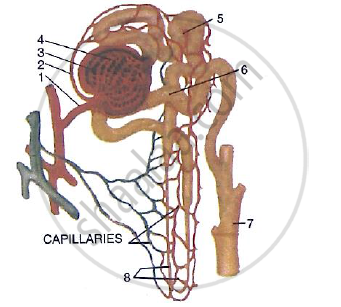Advertisements
Advertisements
प्रश्न
The organs A of a person have been damaged completely due to which too much of a poisonous waste material B has started accumulating in his blood, making it dirty. In order to save this person's life, the blood from an artery in the person's arm is made to flow into long tubes made of substance E which are kept in coiled form in a tank containing solution F. This solution contains three materials G, H and I in similar proportions to those in normal blood. As the person's blood passes through long tubes of substance E, most of the wastes present in it go into solution. The clean blood is then put back into a vein in the arm of the person for circulation.
(a) What are organs A?
(b) Name the waste substance B.
(c) What are (i) E, and (ii) F?
(d) Name G, H and I.
(e) What is the process described above known as?
उत्तर
(a) Organ A is kidney. Complete damage of the kidney (organ A) can lead to the accumulation of waste material B, i.e. urea, in the blood.
(b) The waste substance B is urea.
(c)
(i) In dialysis, the blood from a convenient artery is pumped into the dialyser of a dialysing machine. The dialyser contains a coiled cellophane tube made of substance E, called cellulose. It is surrounded by the dialysing solution (F). Hence, E represents cellulose.
(ii) F represents the dialysing solution.
(d) The dialysing solution contains water (G), glucose (H) and salts (I), which is similar in concentration to those in normal blood.
(e) The process of removing waste substances like urea from the blood using a kidney machine is known as dialysis.
APPEARS IN
संबंधित प्रश्न
The kidneys in human beings are a part of the system for ______.
Explain Selective reabsorption
A dialysis machine contains long tubes coiled in a tank containing dialysing solution
What does the dialysing solution contain?
What are the methods used by plants to get rid of their waste products?
Name the following:
The tuft of capillaries inside the Bowman's capsule.
Write down the functional activity of the following parts,
Henle's loop ………………
Differentiate between the following pairs of terms:
Bowman’s capsule and malpighian capsule.
Differentiate between the following pairs of term :
Renal pelvis and renal papilla
The following diagram represents a mammalian kidney tubule (nephron) and its blood supply.

Parts indicated by the guidelines 1 to 8 are as follows:
1. Afferent arteriole from renal artery
2. efferent arteriole
3. Bowman’s capsule
4. Glomerulus;
5. Proximal convoluted tubule with blood capillaries;
6. Distal convoluted tubule with blood capillaries;
7. collecting tubule;
8. U-shaped loop of Henle
Study the diagram and answer the question that follow:
Where does ultrafiltration take place?
Answer the following question:
Explain the human excretory system with the help of a suitable diagram.
Explain the Term: Glomerulus
Name the Following
The Inner concave margin of kidney.
Complete the following sentence with appropriate word:
Besides excretion, the kidneys also carry out the important function of ______.
Choose the Odd One Out:
Answer the following question.
State the role of liver in urea production.
Answer the following question.
Why do we get bad breath after eating garlic or raw onion?
The habitat of animals that excrete nitrogenous waste in the form of urea.
The process of diffusion of solvent particles from the region of less solute concentration to a region of high solute concentration through a semi-permeable membrane is known as ____________.
Two green plants are kept separately in oxygen-free containers, one in the dark and the other in continuous light. Which one will live longer? Give reasons.
Name the organs that store and release the urine.
